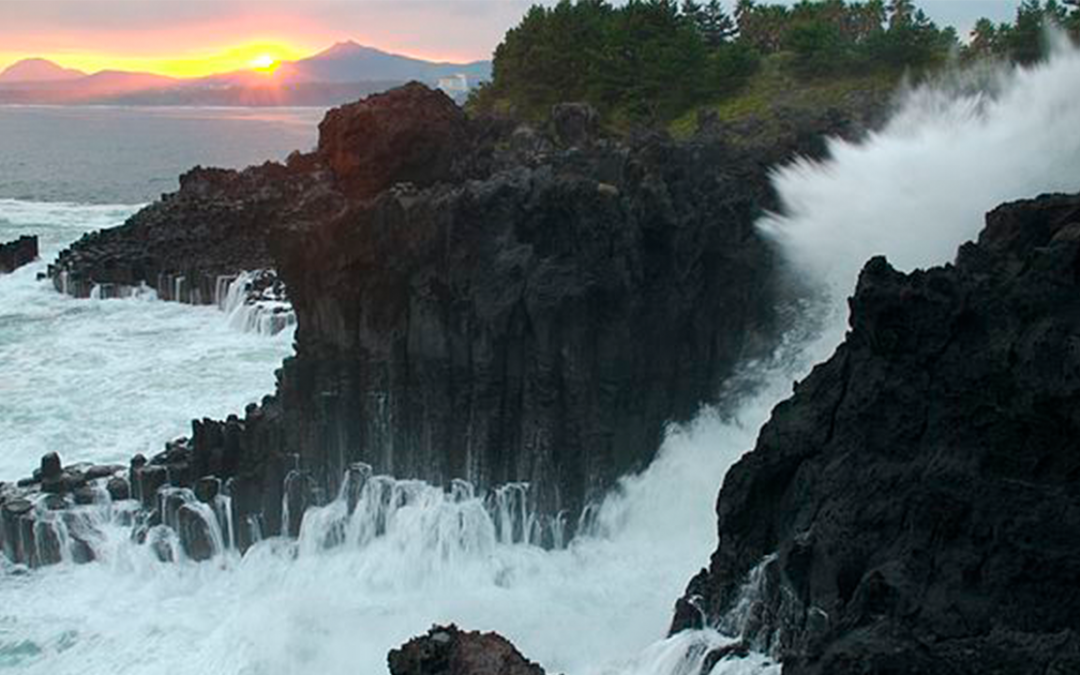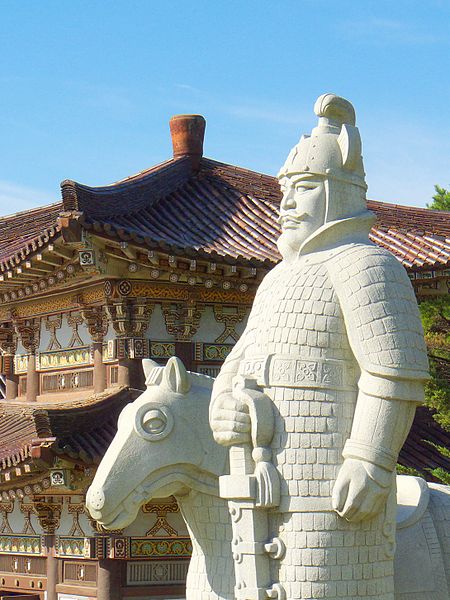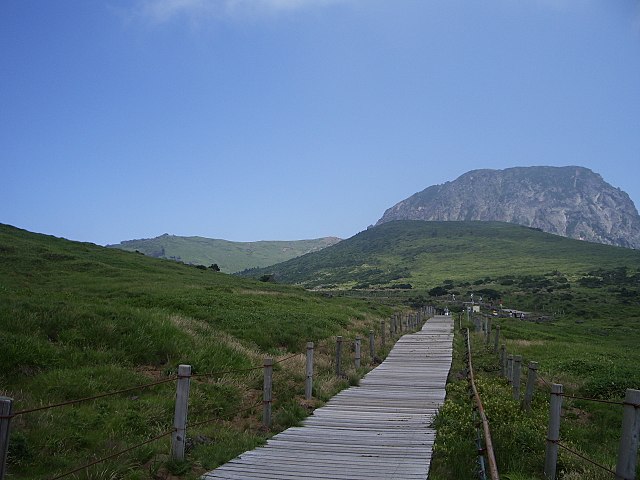Korean gods are some of the most fascinating of world mythology. From Jumong, the master archer who founded Korea, to the amazing gods Jeju island, this is a list of fascinating Korean gods.
1) Jumong – The Master Archer Who Founded Korea
According to legend Jumong was almost never born. His mother was the goddess Yuhwa who gave birth to an egg. King Keumwa stole the egg, and tried to destroy it. He went to a stable to have it trampled by horses, but none of the horses would trample it. He then left it in the forest, but none of the animals in the forest would even go near it. He tried to keep Yuhwa from keeping the egg warm so that whatever was inside would die. However, the father of the egg was the sun god Haemosu. Haemosu used a ray of light, to shine down on the egg, and keep it warm so it could hatch.
At this point King Keumwa gave in, and the god Jumong hatched from the egg. Jumong grew up to be an adult in only 30 days. As an adult he could shoot an arrow with pinpoint accuracy. This talent would be invaluable to him. Unfortunately, the king’s sons resented Jumong’s talent, and made this clear. Since Jumong was not welcome, he decided to leave, and try to unify the Gojoseon territories which had been broken up by the corruption of the Han dynasty.
King Keumwa chased him down, and cornered him at the Kaesa River. Jumong was kind hearted, and didn’t want to harm the king. He instead shot an arrow in the river, and gave orders to the fish. They formed a bridge out of their bodies, and allowed him to cross. The king and his men pursued him, but once Jumong reached the other side, the bridge collapsed and the pursuers fell into the river.
2) Dangun
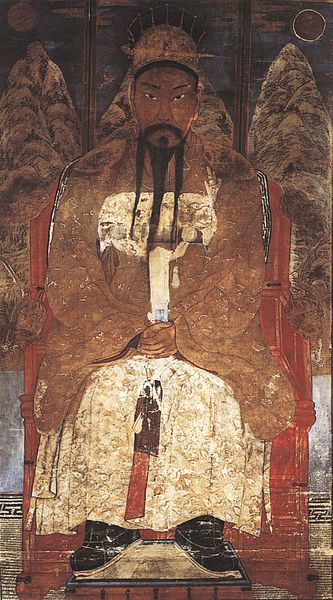
Dangun was the legendary god founder of the ancient kingdom of Gojoseon. Gojoseon began ruling northern Korea in 2333 BC. Dangun was the son of Ungyo, a bear turned goddess who married Hwanung. Dangun established the walled city of Asadal, and named his new kingdom Joseon, although it is now referred to as Gojoseon which means ‘old Joseon’. This kingdom would last from 2333 BC to 108 BC. Dangun not only created the first korean kingdom but also created the Korean race itself. Dangun ruled for a total of 1000 years before choosing to become a spirit, and live a life of meditation at the Heavenly Lake on Mt. Paektu.
3) Hwanung

Hwanung is the ‘Supreme Divine Regent’, son of the ‘Lord of Heaven’, and father of Dangun, who founded the first Korean kingdom. He appointed ministers of clouds, rain, and wind, and worked with them to create laws and moral codes. He also took it upon himself to teach humans arts, medicine and even agriculture.
Hwanung had a deep desire to leave heaven and live on Earth, among the valleys and the mountains. Hwanin, who was the ruler of the heavens and Hwanung’s father, permitted this. Hwanung left for Earth with 3000 followers.They landed on Baekdu Mountain, where Hwanung founded Sinsi, the ‘City of God’. He gave himself the title of ‘Heavenly King’. There was a sandalwood tree in the area they had descended to. Everyday a bear and a tiger came to the sandalwood tree to pray to Hwanung. One day Hwanung decided to give the tiger and bear twenty bulbs of garlic, and some divine mugwort each. He told them that if they were to eat nothing but the garlic and mugwort and stayed in a cave away from sunlight for one hundred days, he would turn them into humans.
Both the tiger and the bear agreed, and went back to their caves. The tiger couldn’t hold back its hunger and left the cave before even 21 days were up. The bear, however, stayed true to her word, and after only 21 days was transformed into a beautiful women. She was so grateful that she would honour Hwanung everyday with offerings. Unfortunately, over time she had grown lonely and prayed to Hwanung for a child. Hwanung decided to make her his wife, and she gave birth to the god Dangun. The name Dangun, means ‘Altar Prince’, and ‘Sandalwood’.
4) Hwanin
Hwanin has many names, Heavenly King, Highest Deity, God of Heaven, and sometimes just Heaven. He is essentially the Korea’s version of Zeus, or Odin, although he certainly has traits of his own. He is the father to all other Korean gods, but also the Sky God. Another interesting name of his, is Okhwang Sangje, “Highest Deity the Jade Emperor”.
In Korean mythology, the gods Hwanin, Hwanung, and Dangun represent a threefold conception of divinity. Hwanin is the transcendent source and god of Heaven, Hwanung is the god of the world between Heaven and Earth. Dangun is the final representation, and is the god of Earth, and its link to Heaven.
5) Munjeon Bonpuri “Annals of the Door”

This myth centres around a father (Namseonbi) and mother (Yeosan Buin) of seven children. The mother is a hard working, and digilant mother, where as the father is layabout, and a gambler. The mother toils to raise money for the family, which Namseonbi then wastes. Since they were stuck in this cycle of poverty, they lacked food to give their children nourishment, and clothes to keep them warm. The mother, Yeosan Buin, thought of a clever idea to break them out of this sick cycle. She sold her most valued heirlooms and bought fancy clothes for her husband, and then told him to use the leftover money to buy grain. Grain was cheap in their village, but by travelling to villages where it was normally more expensive, they could make a profit. When Namseonbi went to other villages to sell the grain, he spent the profit on rice wine, and gambled the rest. He even sold the expensive clothes he had, just to gamble that away too.
Noiljadae was the daughter of the owner, of the inn Namseonbi was currently staying at. Noiljadae forced forced Namseonbi to live in a small hut, he made himself. Namseonbi turned blind from the food he had to eat eat. Noiljadae even murdered Namseonbi’s wife when she came to look for him. Noiljadae disguised herself as Yeosan Buin, and erscorted Namseonbi back to the village with. She still believed he was rich, and was plotting to steal from him. Her plot didn’t last. Namseombi and his family managed to stop Noiljadae. Seocheon, the god of flowers, revived Yeosan Buin. Each member of the family became the guardian deities of different parts of the house. Yeosan Buin became the goddess of the kitchen, hearth, and fire. Namseonbi became the defender of the dark fertilizer shed. Five of their seven children became Korean gods who defended each cardinal direction, North, West, East, South, and Centre. The last two became the guardians of the back door, and front door respectively. Noiljadae became the goddess of the bathroom.
6) Hwangok

Hwangok was a mysterious princess from India, who came to Korea after being sent by the gods to marry the god Kimsuro. However, there are no Indian records of such a princess ever existing. Despite this, there are 6 million Koreans today who claim to be descended from her. After marrying the god, she explained how she came to arrive in Korea. The god Sange Je had spoken to her parents in a dream, and told them to send her to Kimsuro. She travelled for two months across the sea, and came across a rare peach, called a Beondo, which only appeared every 3000 years. There were countless maidens who wanted to marry Kimsuro, but none could entice him. He knew in advance that a woman had been sent by the gods, and was waiting for her to arrive. His servants saw her boat, and informed him of her arrival. Not long later they had gotten married.
7) Kimsuro
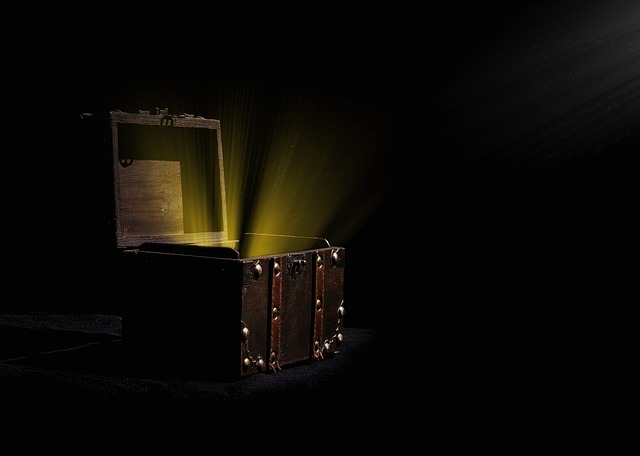
Nine lords, ruled the region of Kaya, one ruler from each of the main city-states. However, the power being split between nine people caused a lot of tension. To resolve the issue, the nine lords prayed to Hwanin for a leader to come down from the heavens and rule over all of them. After praying to the supreme deity, a voice came from the heavens and spoke the people of the Kaya region. Hwanin sent down a golden chest, which held six eggs.
The god Kimsuro and his five subordinates hatched from the eggs. Kimsuro took control of the nine cities and became ruler of the entire region. Kimsuro was evidently a strong leader, which is emphasised by the fact that he grew to nine feet tall only days after his birth, as did all of his subordinates. He defeated the god Talhae in a duel, and proved his strength beyond doubt. Unlike some gods of Korean mythology Kimsuro was not satisfied with a normal human for a wife, and refused to marry until a bride had been sent from the heavens. This wife turned out to be Hwangok, the Indian princess.
8) Igong Bonpuri: The Story of Hallakgungi

Hallakgungi is the deity that looked after the realm of the Fields of Seocheon, which translates to ‘flower fields of the west’. The story of Hallakgungi, begins with his grandparents. One of which was poor, and one of which was rich. They both turned 40 on the same day, and even though one was rich, and one was poor, they were both childless. Each of them prayed for a child, and both of their prayers were answered. One of them received a boy, and the other received a girl. When the children grew older they married each other, and soon the girl (Wongang Ami) became pregnant.
Before she could give birth, the boy (Sara Doryeong) dreamt that the supreme deity was calling him, and wanted him to govern the Fields of Seocheon. They both set off to travel to the fields of Seocheon, but Wongang Ami couldn’t finish the arduous journey, while still pregnant. Doryeong resorted to selling her, and her unborn child for coins, and continued the journey alone. Before parting with them, he broke his comb in half, and told his wife to give it to their child when they want to find their father. Later she gave birth to a son, and named him Hallakgungi. Hallakgungi would go on to become the next caretaker of the Fields of Seocheon, after finding his father.
9) Solmundae Halmang
Solmundae Halmang is a giant goddess who would shape the island of Jeju in a number of shocking ways. Solmundae is a goddess who shaped Jeju Island, in Korea. Her name means ‘Grandmother’ in English. She can turn into a giantess which is so tall that the highest mountain on Jeju Island only reaches her elbow, and if she were to step into the deepest river, the water wouldn’t go higher than her ankle. Grandmother created the 360 mountains of Jeju, when she ate millet porridge. The porridge caused the giant to suffer from diarrhoea, which created all 360 mountains. There is an island near Jeju Island which used to connected to the mainland, but Grandmother had to urinate and as a result cut the land with her burst and caused part of the island to drift away. The land that drifted away became Udo island.
Solmundae Halmang, and Solmundae Halubang (Grandfather), were both hungry and went fishing in Sopchikochi. There method of fishing was creative, to say the least. Grandfather took off his clothes and jumped into the water, which caused such powerful waves that the fish were blown towards Grandmother. Grandmother opened her legs, and allowed all of the fish to blow into her vagina. Grandmother, was quite proud of how tall she was, but considering her actions that pride could easily have been called arrogance. She was so proud of her height, that she wanted to test it against the water, and see if any river on Jeju was deep enough to engulf her completely. The deepest river could only reach her ankle, so she tried a lake. But, the deepest lake could only reach her knee, so she resorted to trying the Mulchangoli ocean. However, Munchangoli was a bottomless ocean, and so she never returned from its depths. The Korean gods that inhabit Jeju are some of the most fascinating in Korean mythology.
10) Koeulla, Pueulla and Yangeulla
Three Korean gods are responsible for the population of one of Korea’s largest islands. These three Korean gods are brothers who lived together on Jeju island. They are the children of Halmang, the giantess. They would spend their time hunting animals, and enjoying the land. At this point there weren’t any humans living on Jeju island, but this changed when the gods found a mysterious chest on the island. Curiosity filled them, they opened the chest and there was a messenger inside. The messenger informed the gods that inside the chest were gifts from the ruler of Pyeongyang.
The chest contained a calf, a colt, and five grains of rice (barley, rice, soybean, foxtail millet, and millet), but more significantly, there were three brides inside the chest. The messenger left on a cloud, and each of the gods took one of the brides for themselves, and formed their own clans on different parts of the island. This is where Jeju’s three major clans originate from, although all of the clans claim to be descendants of the first born of the gods. Legend says that all of Jeju’s current clans descended from these three mythical clans.

